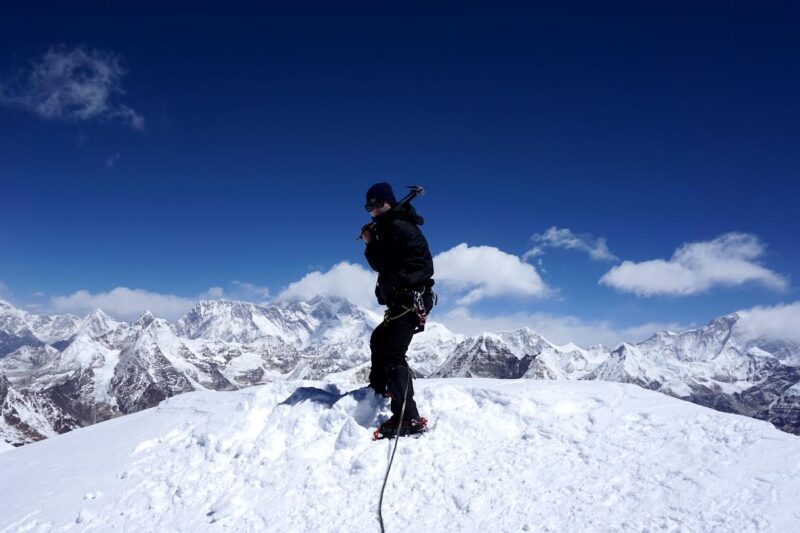There’s something magnetic about Mount Everest. It captures the imagination, drawing people from all over the world to test their limits and reach its towering, snowy peaks. But before you lace up your boots and dream of planting a flag on the summit, there’s a lot to consider.
Climbing Everest isn’t just about fitness or ambition. It’s a massive undertaking that requires physical preparation, mental strength, and serious planning.
I’d love to share some essentials I’ve picked up from researching this mountain and talking to experienced climbers. Whether you’re still deciding or committed to making the trek, there are a few things you’ll want to keep in mind as you plan.
1. Choosing the Right Route

Everest offers more than one way to the top. Two primary routes attract climbers: the Southeast Ridge in Nepal and the North Ridge in Tibet. Each one has its challenges, benefits, and character.
If you want more information on the routes and logistics involved in climbing, check out this Everest Expedition guide, which details the options for both the Southeast Ridge and North Ridge.
The Southeast Ridge (Nepal)
This is the most popular route and the one many climbers take. Starting from the Khumbu Valley, you’ll travel through beautiful but tough landscapes, including the infamous Khumbu Icefall. One of the draws here is that Nepal’s government makes it easier to get permits, and the route has more established infrastructure for climbers.
The North Ridge (Tibet)
If you’re looking for a quieter and slightly less crowded climb, the North Ridge might be worth considering. Accessible via Tibet, this route is technically challenging, but it’s a bit cheaper, and there are fewer climbers.
Be prepared, though—the North side is less forgiving when it comes to harsh winds and colder temperatures.
Whichever route you pick, it’s good to remember that each comes with unique obstacles. Look into each one’s specific requirements and match them with your own skill set and stamina.
2. Building Your Climbing Skills and Experience

Everest is not a place to try out mountaineering for the first time. Most people who succeed on Everest already have experience with high-altitude climbing, often from peaks over 6,000 meters. Here are a few steps to get you ready:
- Climb Nearby Peaks: Tackling mountains in the Himalayas, Andes, or even the Rockies can help you get comfortable with high altitudes.
- Practice Technical Skills: Ice climbing, using crampons and ropes, and dealing with exposed ridges are skills you’ll need on Everest. If possible, work with a guide to hone your technique.
- Build Physical Endurance: Everest demands peak physical fitness, and endurance training is key. Focus on cardio, leg strength, and core stability.
Starting small and progressively moving up to larger, tougher mountains will help build confidence and experience before taking on Everest.
3. The Cost Factor
Climbing Everest isn’t cheap, and costs can vary depending on your approach. In general, a full expedition can range from $35,000 to over $100,000.
Factors Affecting Costs
- Permit Fees: Just getting permission to climb can set you back anywhere from $11,000 in Nepal to about $7,000 in Tibet.
- Guides and Sherpas: Hiring local expertise is crucial, especially if you’re not a seasoned climber. Guides and Sherpas ensure safety, and while they add to the cost, they’re essential.
- Gear: Cold-weather gear, technical climbing equipment, and emergency supplies aren’t optional. And remember, quality matters—you want gear that’s reliable and durable.
- Training Costs: Gym fees, climbing lessons, and prior expedition costs all add up.
Creating a solid budget and planning for unexpected expenses can help you avoid financial strain and focus more on the adventure itself.
4. Acclimatization and Dealing with High Altitudes

One of the biggest dangers on Everest is altitude sickness, a condition that can turn deadly quickly. To make it up the mountain, you’ll need to go through a careful acclimatization process.
What to Expect
- Base Camps: Climbers spend days at Base Camp and several camps up the mountain to help their bodies adjust to the lower oxygen levels. Patience is essential.
- “Climb High, Sleep Low” Strategy: This technique involves climbing to higher altitudes during the day and returning to a lower elevation to sleep. It’s a proven way to acclimate your body.
Listen to your body and know the symptoms of altitude sickness. Headaches, nausea, dizziness, and shortness of breath can signal that it’s time to rest. Altitude acclimatization is crucial, and patience can make or break your journey.
5. Building Mental Resilience
Surviving and thriving on Everest isn’t just a physical challenge. The psychological aspect is huge.
You’ll be dealing with isolation, freezing conditions, physical exhaustion, and even boredom. Having the mental strength to persevere is just as important as having physical strength.
Tips for Building Mental Toughness
- Practice Visualization: Imagine the journey, especially the tough moments, and mentally prepare yourself to push through.
- Work on Meditation and Breathing Techniques: Stress management can help you stay calm in high-stress situations.
- Build a Support System: Whether it’s family, friends, or fellow climbers, having people cheering you on can help you stay positive and grounded.
6. Packing Wisely

Packing for Everest is all about balancing weight and functionality. You need enough gear to keep you safe and warm without being overloaded.
Essential Gear
- Clothing Layers: From base layers to outer jackets, you’ll need several layers to adjust to changing temperatures.
- Climbing Equipment: Ice axes, crampons, harnesses, and ropes are non-negotiable.
- Oxygen Supplies: At extreme altitudes, supplemental oxygen becomes necessary. Make sure you know how to use the equipment properly.
- Medical Kit: Include altitude medications, first-aid supplies, and anything specific to your personal needs.
- Food and Water: High-energy snacks and hydration options (like insulated water bottles) are crucial. The body needs extra calories at high altitudes.
Focus on functionality and durability. Lightweight yet tough gear will make a difference.
7. Respecting the Culture and Environment
Everest is more than just a mountain—it’s sacred to local communities, and the environmental impact of climbers can be huge.
Respecting the mountain and the people who live there isn’t just ethical; it’s essential for preserving Everest for future adventurers.
Ways to Show Respect
- Pack Out Waste: Whatever you bring up the mountain, take it back with you. Trash on Everest is a big problem, and each climber can help minimize it.
- Respect Local Customs: Sherpas and local guides play a huge role in the Everest community. Learning a bit about their culture can go a long way.
- Stay Within Your Limits: Pushing beyond your skills or health limits can put others in danger, including the people who might come to your aid.
Being mindful of the environment and the culture around Everest is just as crucial as planning the climb itself.
8. Preparing for the Unexpected
Even with the best training and planning, the mountain can be unpredictable. Weather on Everest changes fast, and situations can arise that test your adaptability and decision-making.
A Few Quick Tips
- Stay Informed on Weather Patterns: Check reliable forecasts and listen to advice from guides who know the mountain’s moods.
- Have a Plan B: If conditions become unsafe, be prepared to turn back. Summit fever, the desire to reach the top no matter what, can lead to fatal mistakes.
- Trust Your Instincts: If something doesn’t feel right, don’t hesitate to speak up or make a different choice. It’s better to be safe and alive than to take unnecessary risks.
Mount Everest isn’t going anywhere, and there’s always another day to try again.
Final Thoughts
Climbing Mount Everest is an achievement like no other. But it’s also a journey that demands immense dedication, patience, and respect. Every year, people take on the challenge of reaching Everest’s summit.
Some succeed, and others have to make the tough decision to turn back. Remember, reaching the top isn’t the only measure of success; sometimes, just making it home safe is the most significant victory.
If Everest calls to you, know that it’s possible—with preparation, respect, and determination. Plan well, be safe, and remember that the mountain will always be there, waiting for those who are ready.
Related Posts:
- 10 Things to Know Before Playing at an Online Casino
- Should You Take That Casino Bonus? Breaking Down the…
- Legal Loopholes in Disability Claims: Closing the…
- Is That Headline True? Easy Ways to Fact-Check…
- Why To Look For Customer Reviews Before Buying CBD Capsules?
- Are Your Expensive Tech Gadgets Covered by Home…








